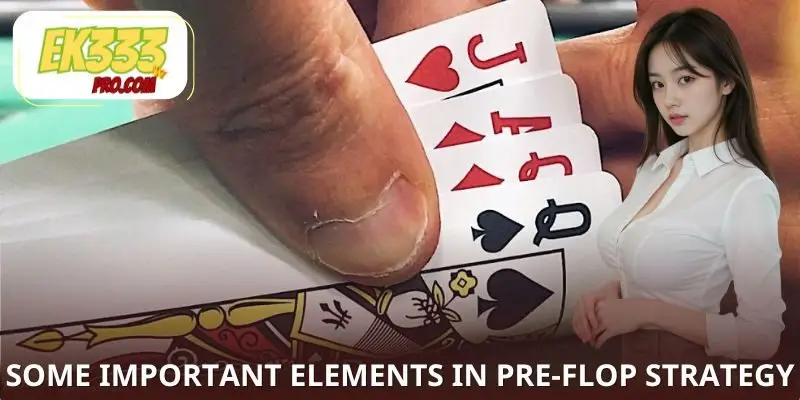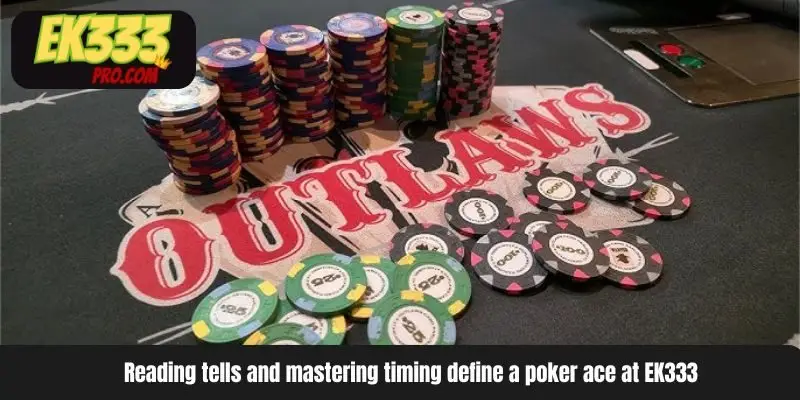Pre-flop tactics in Omaha play a crucial role when players enter a hand, especially given the game’s characteristic of multiple hole cards. Applying these tactics flexibly helps you maximize advantages while minimizing risks. With support from EK333 your gameplay experience becomes more professional, strategic, and secure.
Overview of Pre-Flop Tactics in Omaha
Pre-flop tactics in Omaha are a set of strategies used before the first community card is revealed. Players must consider hand strength, table position, and opponents’ actions. Correctly analyzing the situation helps optimize winning potential. This strategy requires not only clear strategic thinking but also situational awareness of table dynamics, opponents’ betting behavior, and your bankroll limits.
In Omaha Poker, there are more possible hand combinations than in Hold’em, making pre-flop decisions a critical foundation for the rest of the game. New players often struggle to assess the true value of their hands with four hole cards. Practicing selective hand choices helps avoid common mistakes. Patience and discipline in following a strategy enhance the overall effectiveness of pre-flop tactics

Key Factors in Pre-Flop Tactics in Omaha
Additionally, considering these key factors allows you to anticipate possible outcomes and adjust your strategy dynamically. For example, being in a late position gives you more information about other players’ actions, enabling more informed decisions on whether to raise, call, or fold. Similarly, evaluating your hand’s potential to form straights or flushes helps determine the level of aggression you should take pre-flop.
Combining position, hand potential, and opponent behavior with disciplined bankroll management ensures that your pre-flop tactics in Omaha are both calculated and adaptable, increasing your chances of success in each hand.
Evaluating Starting Hand Value
In pre-flop tactics, not all starting hands are created equal. Hands with strong connectivity and the potential to form straights or flushes hold a significant advantage. Players should avoid being tempted by unpaired, unsuited, or disconnected cards, as they rarely build strong combinations and often drain the bankroll in later rounds.
Accurately assessing your starting hand saves bankroll and prevents unfavorable situations. Mastering this principle provides a strong foundation for the rest of the hand.
Seat Position and Its Strategic Impact
Position is a critical factor in pre-flop tactics in Omaha. Being seated later in the betting order allows you to observe opponents’ actions before making your decision. This provides a significant advantage by reducing risk and increasing control over the hand.
Conversely, acting early requires greater caution due to limited information. Smart players adjust their hand range based on position to avoid being forced into a passive or disadvantageous spot.
Additionally, understanding position helps in planning both aggressive and defensive strategies. Players in late position can apply pressure with well-timed raises or capitalize on weak plays from opponents acting earlier. For example, raising from the button after multiple folds can steal blinds effectively, while early position requires stronger starting hands such as suited connectors or high pairs.
Meanwhile, those in early positions need to play more conservatively, focusing on stronger starting hands and avoiding unnecessary confrontations. By factoring seat position into your pre-flop tactics in Omaha, you enhance your ability to make informed decisions, manage risk effectively, and gain a strategic edge throughout the hand.

Observing Opponents and Adjusting Actions
In pre-flop tactics in Omaha, analyzing opponents’ behavior provides valuable insights. Watching how they bet, call, or fold helps identify their playing style. Remembering these tendencies allows you to adjust your hand participation range accordingly.
Experienced players often use this information to execute well-timed bluffs or protect strong hands. The ability to read opponents effectively from the pre-flop stage offers a long-term strategic advantage.
Practical Tips for Applying Pre-Flop Tactics in Omaha
In addition, mastering pre-flop tactics requires adapting your strategy based on table dynamics and player tendencies. Observing how opponents react to different bet sizes and positions can give you valuable insights into their likely hand strength.
By combining this information with careful hand selection and proper bankroll management, you can make more informed decisions, reduce unnecessary risks, and increase your chances of building strong hands as the community cards are revealed. Over time, this disciplined approach allows you to play more confidently and consistently, turning pre-flop tactics into a powerful tool for long-term success.
Choosing Strong Starting Hands
Evaluating starting hands is a crucial step in pre-flop tactics in Omaha. Players should focus on cards with potential to form straights or flushes rather than disconnected pairs. Selecting the right hands reduces risk from the very first round.
For beginners, discarding uncoordinated hands minimizes difficult situations in later rounds. Small pairs without straight potential are often disadvantageous, while connected suited cards offer better long-term strategic opportunities.
Effective Bankroll Management
Pre-flop tactics cannot succeed without proper bankroll management. Dividing funds into smaller portions ensures longer participation. When holding a promising hand, you can increase your bet appropriately. Conversely, when uncertain of a hand’s value, keep bets low to protect your bankroll. Many players fail by over-betting in the early rounds. Maintaining patience and balanced stakes provides a sustainable advantage throughout the game.

Watching and Interpreting Opponents’ Moves
A key part of pre-flop tactics in Omaha is closely monitoring and interpreting your opponents’ behavior. Paying attention to how they raise, call, or fold can provide valuable insights into the strength of their hands and their overall playing style. By noting patterns and repeated actions, you can begin to predict their tendencies, such as whether they are conservative, aggressive, or prone to bluffing.
For example, an opponent who consistently raises aggressively from early position likely has a strong starting hand, while a player who only calls small bets may be more cautious or speculative.
Additionally, observing timing and body language, if playing in live settings, or betting patterns in online play, can help you identify opportunities to exploit weaknesses or avoid traps.
Over time, building a mental profile of each opponent allows you to make more informed decisions, adjust your betting strategy, and optimize the effectiveness of your pre-flop tactics. This careful analysis transforms each hand into a strategic puzzle, giving you a competitive edge at the table.
Conclusion
Pre-flop tactics in Omaha form the foundation for shaping each hand. Understanding hand value, table position, and opponents’ behavior is essential for optimizing your strategy. With the safe and transparent support of EK333, you can confidently apply these tactics effectively.

 Poker Ace Strategy – Mastering Smart Play at EK333
Poker Ace Strategy – Mastering Smart Play at EK333  Poker Variants – Master the Fundamentals for EK333 Success
Poker Variants – Master the Fundamentals for EK333 Success  Self-Management and Mindset Strategies for Poker at EK333
Self-Management and Mindset Strategies for Poker at EK333  Bluffing Techniques In Texas Holdem
Bluffing Techniques In Texas Holdem  Texas Holdem Strategy: Skills to Dominate the Table
Texas Holdem Strategy: Skills to Dominate the Table  Omaha vs. Texas Holdem: Which Poker Style Fits You Best?
Omaha vs. Texas Holdem: Which Poker Style Fits You Best?